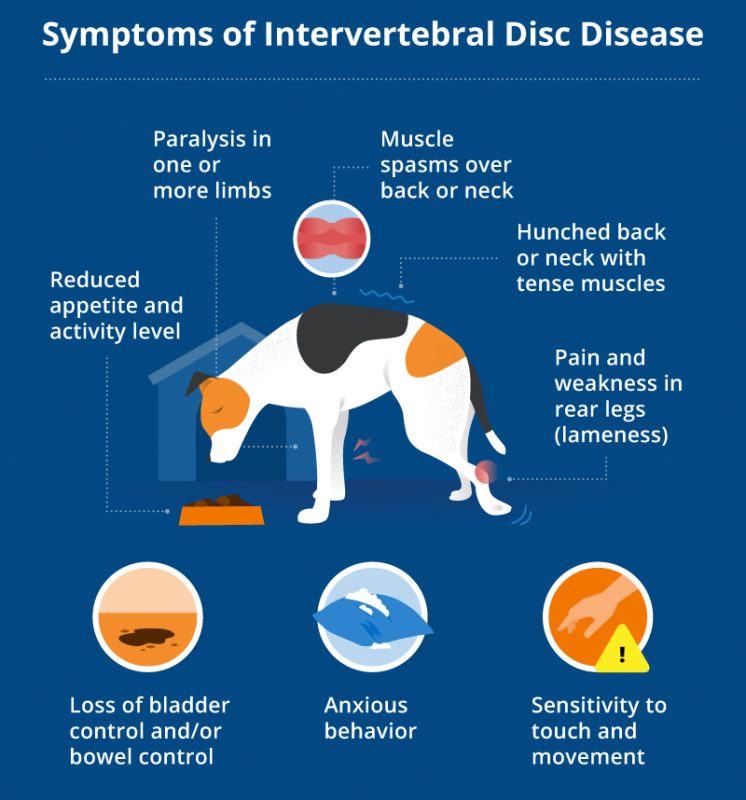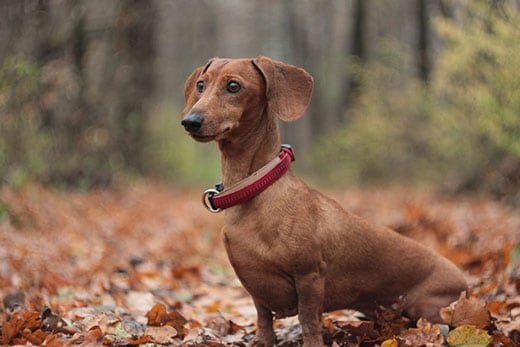
Canine Intervertebral Disc Disease (BDMD): Symptoms, Diagnosis, Treatment, and More
Like humans, the dog’s spine is made up of bony vertebrae with pads, or discs, between them. Canine intervertebral disc disease (MDD) occurs when disc material bulges into the spinal canal. This causes pain and leads to weakness or inability to walk. BMPD in dogs occurs in the neck, and also in the middle and lower back.
Contents
Types of Intervertebral Disc Disease in Dogs
Diagnosis of BMPD diagnosis in dogs varies by type. The most common of these is found in chondrodystrophic breeds – dogs with short legs and a long body, for example dachshunds, and usually first develops in an acute form. Of the other two types, one is more chronic and initially progressive and more common in older large breed dogs, while the other has an acute onset and is usually associated with trauma or exercise.
In addition to Dachshunds, intervertebral disc disease is common in other chondrodystrophic breeds such as Shea—tsu and Pekingese. In general, it can develop in almost any dog, both small and large.
Symptoms of back pain in dogs
While some of the signs of pain associated with BMPD in dogs may be subtle, the most common are:

- pain sensations;
- weakness in the limbs or difficulty walking;
- inability to step on one or more limbs;
- general decrease in activity;
- inability to lie down comfortably;
- reluctance to jump or climb stairs;
- lack of appetite.
If the dog shows signs of painShe needs further examination by a veterinarian.
Diagnosis of intervertebral disc disease in dogs
The first thing to understand is that the symptoms of BMPD are often similar to those of many other spinal disorders. However, there are often clues in history and examination results that point to a higher likelihood of certain alternatives.
A veterinarian may suspect this disease in a dog after providing information about its breed, age, and symptoms that have been observed at home. Additional information will be provided by a physical examination and signs of neck/back pain. He will also perform a neurological examination to determine which part of the spine is damaged and assess the severity of the situation. This is extremely important in deciding which additional diagnostic or treatment methods to recommend.
Depending on the severity of the injury, your veterinarian may urgently refer your pet to a neurologist or surgeon for advanced imaging and possibly surgery.
Diagnosis of BMPD in dogs may require advanced imaging studies, most commonly MRI or CT. Scanning allows you to diagnose the location and degree of disc protrusion. Advanced imaging studies are usually performed under anesthesia in the presence of a veterinary neurologist or surgeon. For a more accurate interpretation of the imaging results, additional diagnostics is carried out – the collection and analysis of cerebrospinal fluid.
Treatment of intervertebral disc disease in dogs
If the dog’s symptoms are mild, treatment with medication and severe restriction of physical activity may be an appropriate course of action. Pain relievers, non-steroidal anti-inflammatory drugs (NSAIDs), and muscle relaxants are commonly prescribed for pets to treat BMPD.
The more difficult part of medical treatment is the strict restriction of physical activity, which is essential for the healing of the disc. This usually means no running, no jumping on furniture and games, and no or no going up or down stairs. Your veterinarian will give specific instructions.
Restriction of physical activity is usually prescribed for a period of four to eight weeks. As difficult as this may be for owners, successfully adhering to such a restriction optimizes the dog’s chances of recovery.

If the condition does not improve or worsens despite following medical advice, a re-examination is recommended. It is best to consult a veterinary neurologist.
Sometimes dog owners just can’t help. Surgery to remove disc material is recommended when a pet’s symptoms do not improve or worsen despite medication and strict rest. It is also necessary when the dog has moderate to severe symptoms already at the initial visit to the veterinarian.
In some cases, clinical symptoms may progress to such an extent that surgery can no longer help. In this case, the likelihood of restoration of limb function and the ability to walk again is very small.
For dogs that only have hind limbs affected, your veterinarian may suggest a dog wheelchair. It is one of the possible options for maintaining the mobility and independence of the animal. In some cases, where the likelihood of recovery of limb function is minimal and the wheelchair option is not suitable for the dog or owner, humane euthanasia may have to be opted for.
Physical rehabilitation with a licensed veterinary therapist who specializes in this field can help maintain and build muscle mass, as well as restore coordination and strength after surgery. Some dogs with BMPD are given it in combination with medication.
Prevention of spinal disease in dogs
Unfortunately, there is no way to completely prevent intervertebral disc disease in dogs. However, there are some steps you can take to minimize stress on your spine. Maintaining a normal weight reduces stress on the back, core, and joints. You can maintain weight with daily physical activity и proper nutrition. In addition, owners of chondrodystrophic dogs are advised to limit the ability of their pets to jump up or down, especially from a considerable height, as this creates additional stress on the spine. In such a case, using a dog ladder can help so that the pet can safely climb onto and off the bed of family members and other furniture.
See also:
- Most Common Diseases in Older Dogs
- Hip dysplasia and other growth disorders in dogs
- Arthritis in Dogs: Symptoms and Treatment
- Helping your dog recover from injury or surgery





